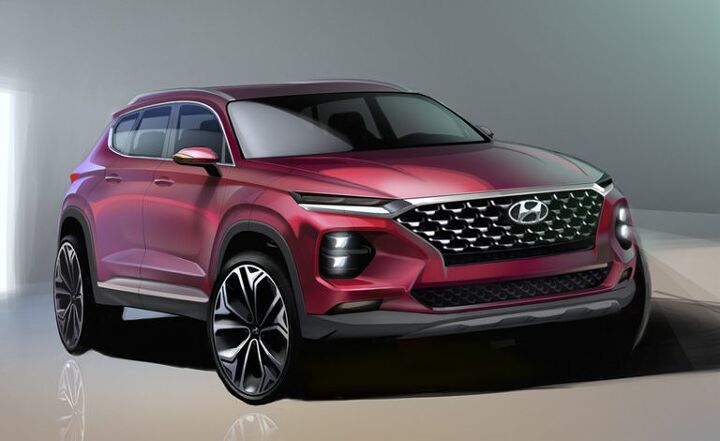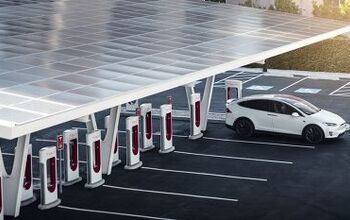2019 Hyundai Santa Fe: Come for the Headlights, Stay for the Brawn

Hyundai’s Santa Fe has been a reliable performer for the automaker, topping up the company’s coffers over three generations and helping turn the crossover segment into the unstoppable juggernaut it is today.
The current generation, dating to 2013, is sufficiently long in the tooth to call for a top-down revamp, the results of which we can see in these official renderings. For 2019, Hyundai’s biggest grows bigger and bolder, but a few mysteries still remain.
As the images show, the new Santa Fe adopts a corporate grille seen everywhere from the subcompact Accent to the Elantra GT, Sonata, and new-for-2018 Kona. Illumination points now cover more real estate as the Santa Fe goes the split-headlamp Kona route: thin daytime running lights up top, main lamps below.
Overall, the crossover loses its prior shapeless form, gaining a high, distinct character line that blends into the rear taillights and adds a bit of upscale panache. Hyundai claims the new design highlights the model’s “robust, stylish and voluminous composition” — a description sure to inspire unwholesome thoughts in some readers. Given that it’s a sketch, we can forgive the exaggerated angles and oversized wheels. Last week, Hyundai teased us with a profile shot of the model that puts these sketches into perspective.
Chrome trim along the lower body and surrounding the rear reflectors signals that this model has no superior in the brand’s lineup.
Would-be buyers won’t have to wait long before the real thing appears. The next-generation Santa Fe debuts at the Geneva Motor Show in March, at which time we’ll learn many unknowns. For example: what powertrains can we expect? Surely, an obligatory 2.0-liter turbo four serves as an entry engine, with Hyundai’s 3.3-liter V6 a likely upgrade. Also, exactly how much larger this new model really is remains to be seen.
We know much less about the Santa Fe’s little brother, the Santa Fe Sport. During the early days of the brand’s crossover shakeup plan, Hyundai suggested the smaller, two-row model might forge its own identity going forward. A more rugged design and a new name (anyone want to make bets on the Southwestern locale?) would place distance between it and the Santa Fe, helping avoid confusion.
Hyundai’s U.S. sales saw a sharp downturn in 2017, even as its crossover sales reached a new high. Given that the automaker touted only the Santa Fe Sport’s volume in its 2017 sales report (up 12 percent), we’re led to believe sales of the larger Santa Fe, which Hyundai groups together with the smaller model, actually fell last year. As the priciest model in the lineup, a new Santa Fe can’t come soon enough.
[Images: Hyundai]

More by Steph Willems
Latest Car Reviews
Read moreLatest Product Reviews
Read moreRecent Comments
- ToolGuy I'm considering purchasing a few new Aston Martin vehicles.
- Spamvw 13 spoke rims from a 2005 Golf, I approve, as I have them on my '02 JSW TDI that hit 480k today.
- ToolGuy New car prices make me queasy will this help with that?
- Kcflyer On the bright side I just saw a commercial where the army is advertising the fact that women are now part of tank crews. I'm sure the compromises necessary to put women in front line combat arms won't in any way weaken our armed forces ability to win wars in the future. But, hey, at least that new BYD SUV will cost more, thanks uncle Joe.
- User This story fails to cite any regulation or trade journal to support the claim that a law suddenly prevented the sale of a product in a market.


































Comments
Join the conversation
They went Hawaiian for the Kona. So... Hyundai Maui! (No, sounds like a dealership.)
A lot of people made fun of the Jeep Cherokee front end treatment when it came out in 2014. Apparently, the Koreans loved it. This one has a more exaggerated treatment of it. Makes the 14-18 Cherokee look downright conservative.